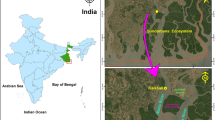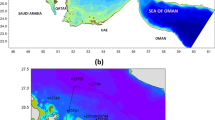Abstract
A field survey was undertaken to reveal the structure of the tidal front in Iyo-nada. An obvious tidal front was found between the mixed region around Hayasui Straits and the stratified region in Iyo-Nada. Its structure was typical in the eastern part and was influenced by the river discharge in the western part. An intense chlorophylla maximum was found in the subsurface layer of the eastern typical front. Analysis using TS diagram suggested that, around the eastern front, there was an intrusion from the mixed water to the middle layer of the stratified water. This intrusion was supposed to be an important process supplying nutrients from the mixed water to the subsurface of the frontal region and causing the intense chlorophylla maximum.
Similar content being viewed by others
References
Fournier, R. O., M. Van Det, N. B. Hargreaves, J. S. Wilson, T. A. Clair and R. Ernst (1984): Physical factors controlling summer distribution of chlorophylla off southwestern Nova Scotia.Limnol. Oceanogr.,29, 517–526.
Legendre, L. and S. Demers (1985): Auxiliary energy, ergoclines and aquatic biological production.Naturaliste Can.,112, 5–14.
Matsuda, O. (1990): Chemical process around the tidal front. p. 78–100. InThe Science of Siome, ed. by T. Yanagi, Koseisha-Koseikaku, Tokyo (in Japanese).
Pingree, R. D. (1978): Mixing and stabilization of phytoplankton distributions on the northewest European continental shelf. p. 181–220. InSpatial Pattern in Plankton Communities, ed. by J. H. Steele, Plenum Press, New York.
Savidge, G. (1976): A preliminary study of the distribution of chlorophylla in the vicinity of fronts in the Celtic and Western Irish Seas.Estuarine Coastal Mar. Sci.,4, 617–625.
Savidge, G. and H. J. Lennon (1987): Hydrography and phytoplankton distributions in north-west Scottish waters.Continental Shelf Res.,7, 45–66.
Simpson, J. H. and J. R. Hunter (1974): Fronts in the Irish Sea.Nature,250, 404–406.
Yanagi, T. and T. Koike (1987): Seasonal variation in thermohaline and tidal fronts, Seto Inland Sea, Japan.Continental Shelf Res.,7, 149–160.
Yanagi, T. and S. Takahashi (1988): A tidal front influenced by river discharge.Dynam. Atmos. Oceans.,12, 191–206.
Yanagi, T., O. Matsuda, S. Tanabe and S. Uye (1992): Interdisciplinary study on the tidal front in the Bungo Channel, Japan. InPhysics of Estuaries and Costal Seas, ed. by D. Prandle, Springer-Verlag, New York (in press).
Author information
Authors and Affiliations
Rights and permissions
About this article
Cite this article
Takeoka, H., Matsuda, O. & Yamamoto, T. Processes causing the chlorophylla maximum in the tidal front in Iyo-nada, japan. J Oceanogr 49, 57–70 (1993). https://doi.org/10.1007/BF02234009
Received:
Revised:
Accepted:
Issue Date:
DOI: https://doi.org/10.1007/BF02234009




